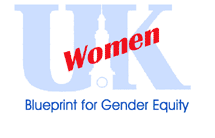
QUICK FACTS ABOUT UK
1. OPPORTUNITIES
“Administration is still male top heavy. Nearly every dean at UK is a man.”
- respondent, May 1999 Survey
-
If UK hiring patterns over the last 10 years continue, the number of women and men in the assistant and associate professors ranks will be equal in 2009. However, the number of women and men full professors will not reach parity until 2049.
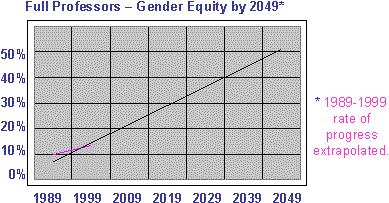
- 1% of all skilled crafts workers are women; whereas, 92% of all secretaries are women.
- At least 13 dean searches were conducted between 1989 - 1999 and they resulted in a total gain of two women in deanships.
- The number of deanships held by women doubled from 2 in 1988 to 4 in 1998, but the increase occurred only in traditionally female disciplines (Education, Social Work, Nursing, and Human Environmental Sciences).
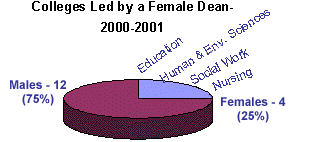
- 11 out of 16 colleges have no woman leading an academic unit .
- At the 1989 - 1999 rate of increase in the number of deanships held by women, gender equity could be achieved in another 10 years.
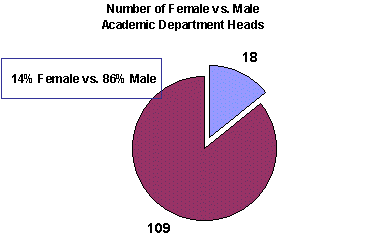
- Almost half of the academic units have 3 or fewer women faculty.
- In 1989 the College of Nursing had no male faculty and in 1999 the College had one male faculty member.
- The Graduate School achieved gender equity in its fellowship awards and other student funding during the last decade.
- Despite the existence of a special initiative to encourage their entrance into fields where women have been traditionally underrepresented, only 21% of all graduate students in those areas are women.
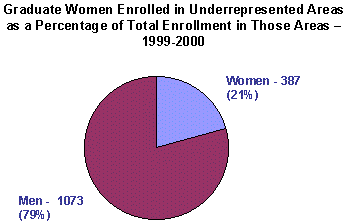
- Women have been hired to fill only 20% of the new faculty positions created by Phase 2 of the Research Challenge Initiative.
- In 1998-1999, only 27% of all Standing Administrative Committees and 20% of Senate Committees were chaired by women.
2. COMPENSATION
- UK has over 10,000 employees; yet, UK’s early childhood center serves only 84 children, offers a half-day program, and is closed in the summer.
- If both spouses work at UK, they must share the 12 weeks of family medical leave available for the birth/adoption of a child. If one spouse is a UK employee and the other works elsewhere, each is entitled to 12 weeks of family medical leave.
- Nine of UK’s new benchmarks, as well as Harvard, Yale, Johns Hopkins, Stanford, MIT, Michigan State, Princeton, and the Universities of Chicago, Indiana, Pennsylvania, Oregon, and Colorado provide Domestic Partnership benefits. UK does not.
- Over 2,000 UK employees, the majority of whom are women, receive no benefits because they are employed less than full-time.
- If a tenure-track woman faculty member takes 6 weeks of family medical leave because of the birth of a first child, she gets a 26-week extension of her tenure clock. She would have to bear 4 more children and take 6 weeks of family medical leave for each before she is entitled to another 26-week extension of the tenure clock.
- Equity has been achieved in retirement contributions such that both the university’s 10% and the employee’s 5% apply to all employees regardless of job classification.
- Over 1,000 employees still hold positions outside the newly instituted personnel system. Approximately 53% of these are in Agricultural Extension, e.g., county agents and clerks. The remaining positions are in university administration and athletics, and 76% are held by men.
“…I would suggest a study comparing the pay of similarly qualified men and women in both faculty and staff positions…. despite having a doctorate I am paid less than $10 per hour.”
- respondent, May 1999 survey
3. PROMOTION
- The UK workforce continues to be extremely segregated by gender.
“It appears that men who do not have the same experience or the same level of education continue to receive promotions and raises above their more highly qualified female colleagues.”
– respondent, May 1999 survey


- In the past 10 years, 180 professional staff women have participated in UKadvance, a university-sponsored professional development program created in response to the first study issued by the Ad Hoc Committee on Women.
- In the same 10-year time period, the number of women in the EEO6 executive/administrative/managerial job category increased by only 55.
- The average annual turnover rate for UKadvance participants since 1992 is 7% as compared to an average 17% turnover rate for all UK staff.
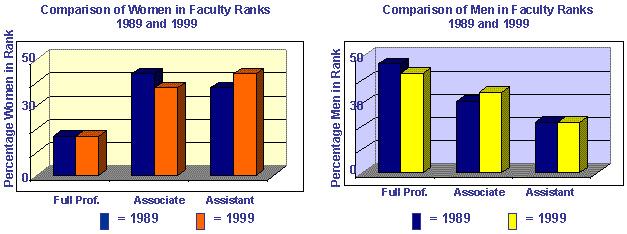
- From 1989 - 1999, the number of African American women on faculty increased from 2 to 9 at the Assistant Professor level and from 1 to 10 at the Associate Professor rank.
- The number of women
at the full professor rank increased from 48 to 80 from 1989 - 1999;
yet they still represent only 17% of all women faculty.
“I think women are overlooked for higher…positions….I have felt the sting of our current status.”
– respondent with more than 10 years of experience at UK, May 1999 survey
4. CLIMATE
- Since 1886, 93% of honorary degrees awarded by UK have been given to men.
- Between 1988 and 1999, 38% of the Great Teacher Awards were given to women.
- Fewer than 1 in 10 newly endowed chairs is named for a woman.
- 66% of all full-time staff employees are women but, in the last 10 years, 75% of the staff members honored with the Nestor Award were men.
- The UK Language Guidelines was published in 1993. Current Administrative and Governing Regulations are free of sexist language.
- Since 1989, approximately 10,000 staff, faculty, and students of the Medical Center have completed mandatory sexual harassment training. No comparable program or requirement exists on the Lexington Campus where the majority of students are enrolled.
- In both 1990 and 2000 there were 4 women and 15 men on the UK Board of Trustees. A woman has never served as Chair or Vice Chair of the Board.
- The Women’s Studies Program and the Women’s Health Center are examples of programs that were developed or significantly expanded in the past decade and that increase the visibility of women’s roles and contributions.
"There is a definite undercurrent of sexism in the department as well as the university as a whole. Making this a place where women's issues and opinions are valued and their presence desired should be our top priority"
- respondent, May 1999 survey
5. ACCOUNTABILITY
- UK is not required to collect data by sex, race, or sex and race, regarding recipients of Research Challenge Trust Fund monies so it does not monitor the representation of women in that program.
- More than 9 out of every 10 newly endowed chairs have been awarded to men.
- 1 in 5 new faculty research initiative hires in 2000 was a woman and only 1 in 50 was a woman of color.
- The last university-wide analysis of salaries and wages for gender bias was conducted ten years ago.
- Official university reports do not evidence an institutional concern for the intersection of sex and race. For example, data specific to African American women and other women of color are not reported in 1998-99 Affirmative Action Plan.
- No institutional funds have been allocated to investigate the effect of UKadvance on the subsequent careers of its approximately 200 participants.
- No institutional procedures exist to collect, analyze or report information on why women employees leave UK.
- The UK Development Office does not track the major donors in its "Fellows" program by sex.
- In 1944-45, women comprised 25% of the faculty; in 1999, they comprise 28% of the faculty.
“What gets measured gets done.”
-an old adage
